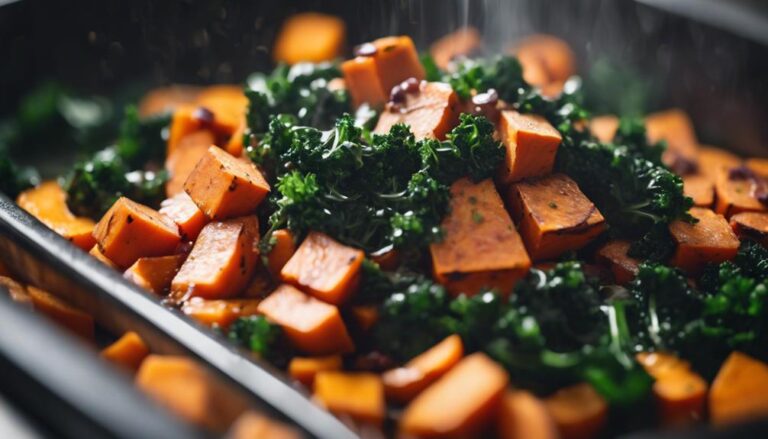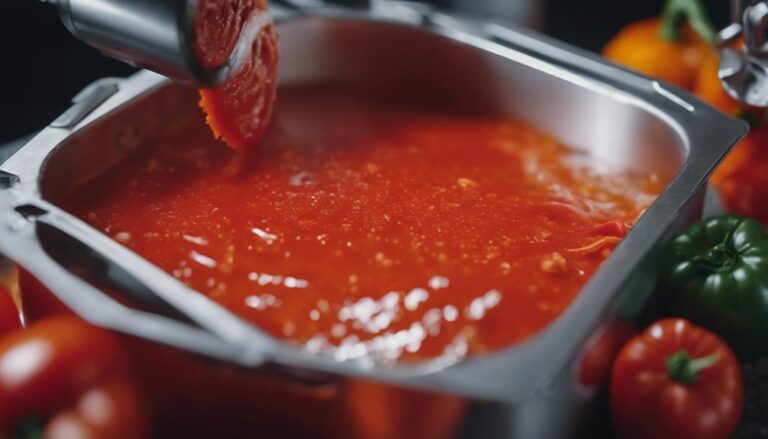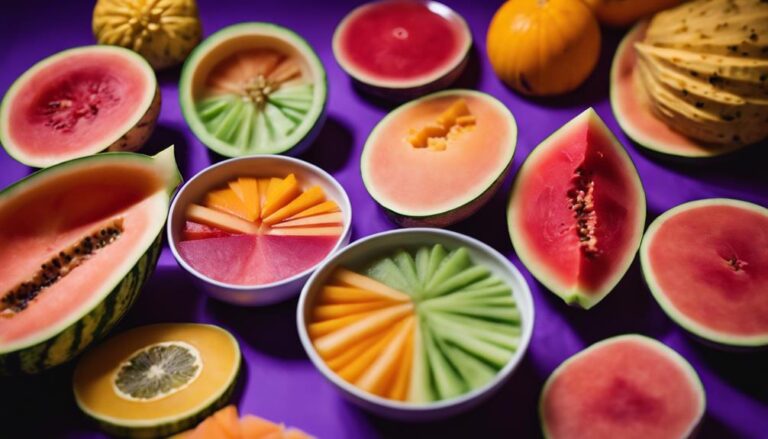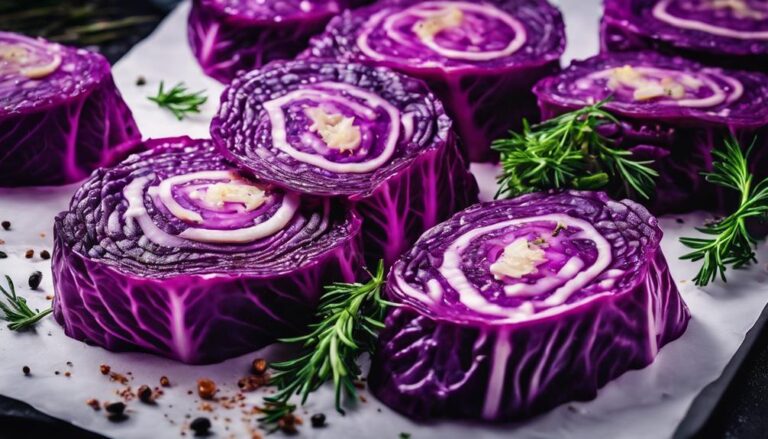Sous Vide Butternut Squash and Apple Soup
Enhance your fall dining with a velvety, flavorful sous vide butternut squash and apple soup. Simplify preparation by sous viding butternut squash, apples, onions, and savory spices in a sealed bag for precise cooking. This method guarantees a creamy, rich texture and seals in vibrant flavors. Finish by blending the tender ingredients into a smooth puree for a luxurious soup experience. Elevate your culinary skills and tantalize your taste buds with this modern twist on a classic favorite. Learn valuable insights and tips to perfect this exquisite dish.
What You Will Learn Here
- Sous vide cooking ensures precise temperature control for a creamy texture.
- Butternut squash and apple soup benefits from sous vide technique for flavor infusion.
- The sous vide method retains flavors and prevents overcooking or undercooking.
- Perfectly balanced texture and consistent results are achieved through sous vide cooking.
- Sous vide butternut squash and apple soup offers a silky-smooth finish for a gourmet experience.
Soup's Ancient Origins
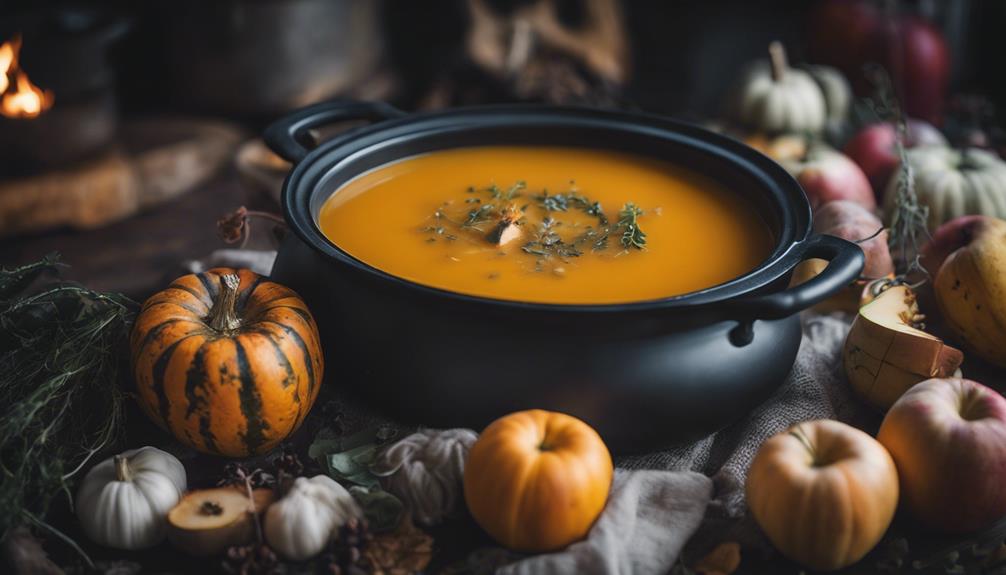
Soup has a long history, dating back to ancient times when it was a staple of many cultures.
The culinary evolution of soup has seen it transform from a simple, nourishing dish to a gourmet delicacy.
Exploring ancient soup recipes gives us a glimpse into the diverse and rich tapestry of culinary traditions that have shaped this beloved comfort food.
Soup's Historical Roots
Originating in ancient civilizations across the globe, the tradition of simmering various ingredients together to create nourishing and flavorful dishes has been a fundamental practice in culinary history. Culinary techniques such as boiling and stewing were used by early societies to cook a variety of ingredients into soups, reflecting the cultural significance of communal dining and resourcefulness in utilizing available foods.
In ancient Egypt, for instance, soups were a common part of meals, often made with vegetables, legumes, and grains. The Greeks and Romans also valued soups for their beneficial effects, often flavoring them with herbs and spices.
In Asia, soups played an essential role in traditional medicine and were believed to promote health and vitality. Chinese cuisine, with its emphasis on balance and harmony, incorporated soups made from medicinal herbs and ingredients to maintain well-being. Similarly, in India, soups known as 'shorbas' were prepared with aromatic spices and herbs, reflecting a rich culinary heritage that continues to influence modern cooking practices.
Throughout history, soups have evolved to become a staple in global cuisine, blending flavors and techniques from diverse cultures to create a comforting and versatile dish enjoyed worldwide.
Culinary Evolution of Soup
Exploring the historical roots of soups reveals a culinary evolution that showcases the diverse techniques and ingredients used in ancient civilizations worldwide. Throughout history, soups have undergone evolutionary trends, adapting to the available resources and cultural preferences of different societies. Ancient civilizations such as the Greeks, Romans, and Egyptians all contributed to the development of soups as a staple in their diets. These early soups often consisted of simple broths with vegetables, grains, and occasionally meats.
Over time, the culinary evolution of soup saw the incorporation of new ingredients and cooking methods. As societies advanced, so did their soup-making techniques. Modern adaptations of soups now include a wide range of flavors, textures, and presentations. From hearty stews to delicate consommés, soups have evolved to cater to diverse palates and dietary needs.
Understanding the evolutionary journey of soup provides insight into how this humble dish has transformed into the beloved culinary staple it's today. By appreciating the historical roots of soups, we can better grasp the significance of traditional recipes and the creativity behind modern interpretations.
Ancient Soup Recipes
Amidst the culinary archives of ancient civilizations lie intriguing recipes that offer a glimpse into the early roots of soup-making. Culinary traditions and cultural influences played a significant role in shaping the ancient soup recipes that have been passed down through generations.
In ancient times, soups were often an essential part of daily meals, providing nourishment and warmth to individuals and communities. These early soup recipes varied widely based on the ingredients available in different regions and the cultural practices of the time. From the hearty broths of the Roman Empire to the aromatic concoctions of ancient China, soup held a special place in the culinary traditions of diverse societies.
Ancient soup recipes weren't only about sustenance but also about communal gatherings and shared experiences. The act of preparing and sharing soup was often a ritual that fostered bonds within families and communities. As you explore the ancient soup recipes of civilizations past, you uncover a rich tapestry of flavors and traditions that continue to influence modern soup-making today.
Soup's Staple Seasonings
Enhance the flavor of your soup by incorporating essential seasonings that elevate the taste profile.
- Seasoning combinations: Experiment with a blend of traditional spices like cinnamon, nutmeg, and allspice for a warm and comforting flavor profile.
- Flavor profiles: Consider adding a touch of sweetness with a hint of maple syrup or honey to balance the savory notes in your soup.
- Herbal infusions: Elevate your soup's taste by garnishing with fresh herbs like thyme, rosemary, or sage for a burst of freshness.
Choosing the right seasoning combinations can transform a simple soup into a culinary delight. By understanding different flavor profiles and experimenting with various herbs and spices, you can create a soup that isn't only delicious but also reflects your personal taste preferences.
Don't be afraid to get creative and adjust the seasonings to suit your palate. Remember, a well-seasoned soup can warm both the body and the soul during the cozy fall evenings.
Savory Fall Soup Selections
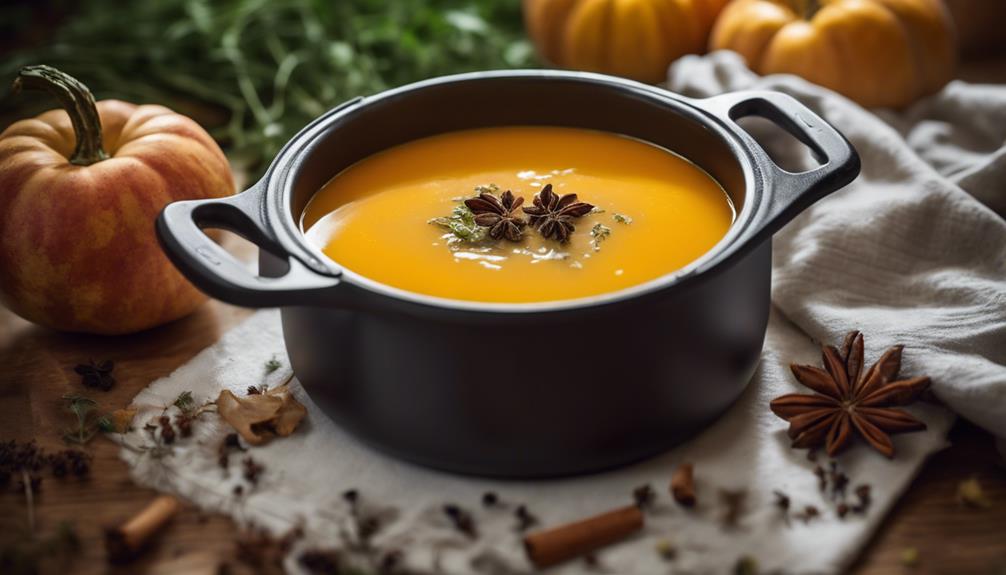
When deciding on savory fall soups, you have a few excellent options at your disposal. Try making a rich Butternut Apple Soup for a sweet and savory twist, a creamy Pumpkin Soup for a comforting classic, or a flavorful Sous Vide Mushroom Risotto for a hearty meal.
These selections capture the essence of autumn and are perfect for warming up on chilly days.
Butternut Apple Soup Recipe
To create a comforting and flavorful Butternut Apple Soup for the fall season, follow this simple recipe.
- Start by gathering fresh Butternut squash and crisp apples from your local market.
- Combine these seasonal flavors in a sous vide bag, adding a touch of modern twist to your traditional soup-making process.
- Let the ingredients cook slowly in the sous vide, allowing the flavors to meld together perfectly.
This Butternut Apple Soup recipe brings together the sweetness of apples and the earthy richness of Butternut squash, creating a harmonious blend of flavors that guarantee autumn. The sous vide method guarantees that every spoonful is packed with intense taste and a velvety texture.
Serve this soup piping hot with a dollop of sour cream or a sprinkle of toasted pumpkin seeds for added crunch. Enjoy the warmth and coziness of fall with each spoonful of this delightful Butternut Apple Soup.
Creamy Pumpkin Soup Recipe
Curiously, what creamy ingredients make up this delightful Pumpkin Soup recipe, a must-try for fall?
- Rich and velvety pumpkin puree
- A sprinkle of warming nutmeg garnish
- A touch of cream for added silkiness
This Creamy Pumpkin Soup recipe captures the essence of fall in a bowl. Begin by simmering the pumpkin puree with aromatic spices until it reaches a smooth consistency. The addition of a nutmeg garnish enhances the earthy flavors, creating a comforting and warm soup perfect for cool autumn evenings. A hint of cream brings a luxurious creaminess to every spoonful, elevating the dish to a whole new level of indulgence. Whether enjoyed as a light lunch or a cozy dinner starter, this Pumpkin Soup is sure to become a seasonal favorite. Try whipping up a batch to savor the taste of fall in a bowl, and don't forget to share this recipe with friends and family to spread the warmth and joy of the season.
Sous Vide Mushroom Risotto
Indulge in the rich flavors of Sous Vide Mushroom Risotto, a delectable addition to your savory fall soup selections. This dish offers a delightful combination of earthy mushrooms and creamy Arborio rice, all cooked to perfection in a sous vide bath. Here are three reasons why you should try this flavorful dish:
- Flavorful Experimentation: The sous vide method allows the mushrooms to infuse their robust flavor deeply into the risotto, creating a dish bursting with savory goodness.
- Texture Perfection: By cooking the risotto sous vide, each grain of rice absorbs the rich broth slowly, resulting in a perfectly creamy yet distinct texture that will leave your taste buds craving more.
- Versatile Pairing: This Sous Vide Mushroom Risotto pairs wonderfully with a variety of proteins or can stand alone as a satisfying meatless meal, making it a versatile addition to your fall recipe repertoire.
Expand your culinary horizons and treat yourself to a bowl of Sous Vide Mushroom Risotto for a dining experience that's sure to impress.
Sous Vide Technique Insights
When it comes to sous vide cooking, the key lies in precise temperature control. This method allows for consistent texture development, ensuring a perfectly cooked dish every time.
Additionally, sous vide enhances flavor infusion, creating a depth of taste that traditional cooking methods may struggle to achieve.
Precise Temperature Control
To achieve peak results when using the sous vide technique, maintaining precise temperature control throughout the cooking process is crucial. Temperature precision is key in sous vide cooking as it guarantees flavor retention and controlled cooking.
By setting the water bath to the exact temperature required for the ingredients, you create an environment where flavors are infused harmoniously, resulting in a rich and well-developed taste profile. This controlled cooking method allows the butternut squash and apple in your soup to gently marry their flavors over time, enhancing the overall taste experience.
The sous vide technique excels in maintaining consistent temperatures, preventing overcooking or undercooking, and providing a reliable way to achieve perfect results every time. With precise temperature control, you can trust that your ingredients are being cooked evenly and thoroughly, resulting in a delicious and flavorful butternut squash and apple soup that captures the essence of each ingredient.
Consistent Texture Development
For achieving consistent texture development using the sous vide technique, maintaining precise temperature control is crucial. This method guarantees that your butternut squash and apple soup reaches the perfect consistency without overcooking or undercooking any ingredients. By keeping the water bath at a constant temperature throughout the cooking process, you can achieve consistent cooking results and maintain a delicate texture balance in your soup.
The sous vide technique allows for a gentle and uniform cooking environment, which is ideal for creating a silky-smooth texture in your soup. With precise temperature control, you can make certain that the butternut squash and apples are cooked to perfection, resulting in a velvety consistency that's both comforting and flavorful. This consistent cooking method helps to preserve the natural flavors of the ingredients while achieving a harmonious texture balance in every spoonful of soup.
Enhanced Flavor Infusion
Maintaining precise temperature control during the sous vide cooking process not only guarantees consistent texture development but also plays a key role in enhancing the infusion of flavors in your butternut squash and apple soup. Flavor infusion in sous vide cooking involves the gentle yet thorough distribution of the ingredients' tastes, resulting in a harmonious blend that tantalizes your taste buds. Unlike traditional cooking methods where flavors can escape through evaporation or be altered by high heat, sous vide allows for a sealed environment where the ingredients marinate in their own juices, intensifying their natural essence.
Taste enhancement in this soup is further heightened by the strategic pairing of butternut squash and apples. The sweet, earthy notes of the butternut squash complement the tartness of the apples, creating a balanced and nuanced flavor profile. This thoughtful ingredient pairing, combined with the precise cooking temperatures of sous vide, makes sure that every spoonful of your butternut squash and apple soup bursts with rich, complex flavors that will leave you craving more.
Final Thoughts

Considering the overall flavors and textures, feel free to experiment with additional seasonings to tailor the soup to your preferred taste. The beauty of this recipe lies in its adaptability to suit your palate. You can play around with different herbs like thyme or sage to enhance the earthy notes or add a touch of nutmeg for a warm, comforting flavor. These culinary techniques allow you to customize the soup to match the seasonal ingredients available, ensuring a fresh and vibrant taste experience every time you make it.
Remember that the sous vide method not only intensifies the natural sweetness of the butternut squash and apples but also preserves their nutrients. This slow cooking process results in a velvety smooth texture that's both satisfying and nutritious. So, whether you enjoy it as a starter for a cozy dinner or as a light lunch option, this soup offers a delightful combination of flavors that celebrate the essence of fall. Try different garnishes like toasted pumpkin seeds or a dollop of crème fraîche to elevate the presentation and add a contrasting texture. Enjoy the warmth and comfort of this sous vide butternut squash and apple soup, made uniquely yours with a personal touch of seasoning.
Frequently Asked Questions
Can This Soup Be Made Ahead and Frozen for Later?
Yes, you can make this soup ahead and freeze it for later. When meal prepping, consider portioning it out before freezing for easier storage. Follow freezing tips to maintain freshness and save time on busy days.
How Can I Adjust the Sweetness Level of the Soup?
To control sweetness, adjust with ingredients like lemon juice or a pinch of salt for balance. Taste test and experiment with variations like maple syrup or cinnamon to tailor the flavor to your preference.
Can I Substitute Butternut Squash With Another Type of Squash?
You can substitute butternut squash with other varieties like acorn or kabocha for flavor variations. Each squash brings a unique taste profile to the soup. Experiment to find the one that suits your preferences best.
Is It Necessary to Peel the Apples Before Cooking?
You should peel the apples for a smoother texture in the soup. Leaving the apple skin on can alter the flavor slightly, but it's a personal preference. Peeling guarantees a consistent texture and a more traditional taste.
Can I Use a Regular Pot Instead of a Sous Vide Machine for This Recipe?
Yes, you can use a regular pot instead of a sous vide machine for this recipe. Simply simmer the ingredients on low heat for an extended time. If you prefer, a slow cooker or Instant Pot can also be utilized.
Conclusion
To sum up, sous vide butternut squash and apple soup is a delicious and nutritious dish that can be easily prepared using modern cooking techniques. By incorporating seasonal ingredients and utilizing the sous vide method, you can create a flavorful and comforting soup that's perfect for fall.
Experiment with different seasonings and garnishes to customize the soup to your taste preferences. Enjoy this hearty soup as a warm and satisfying meal during the cooler months.








